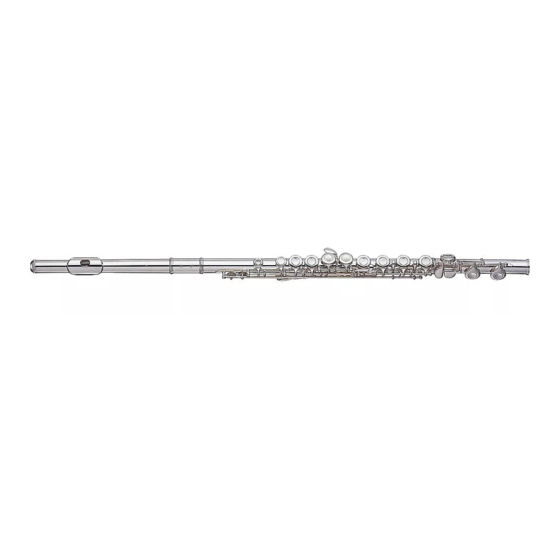
Advertisement
Quick Links
Advertisement

Summary of Contents for Yamaha YFL-221
- Page 1 ピッコロ / フルート 取扱説明書 日本語 Piccolo/Flute Owner’s Manual ENGLISH Pikkoloflöte/Querflöte Bedienungsanleitung Piccolo/Flûte DEUTSCH Mode d’emploi Flautín/Flauta Manual de instrucciones FRANÇAIS 短笛 / 长笛 使用手册 ESPAÑOL Пикколо/Флейта Руководство пользователя 피콜로 / 플루트 사용설명서 中文 Русский 한국어...
- Page 2 야마하 악기를 구입해 주셔서 감사합니다 . 악기의 알맞은 조립 방법 및 보관을 위해 본 사용설명서 Vous êtes dès à présent le propriétaire d’un instrument de musique de haute qualité. Nous vous remercions d’avoir choisi Yamaha. En 를 반드시 읽어주시기 바랍니다 .
- Page 3 Piccolo/Flute Be careful not to touch the pin springs during maintenance, etc. Take care not to disfigure the instrument. The end of the pin springs found on high-end models Placing the instrument where it is unstable may cause Owner’s Manual is sharpened to provide greater key action.
- Page 4 Nomenclature ■ Piccolo ■ Flute Headjoint Headjoint Headjoint Crown Body Body Body Crown Lip Plate Crown Embouchure Hole Embouchure Hole Footjoint Footjoint Embouchure Hole Keys Keys Keys...
- Page 5 ■ Alto Flute ■ Bass Flute Crown Body Headjoint U-Joint Hand rest Lip Plate Body Embouchure Hole Headjoint Embouchure Hole Lip Plate Footjoint Lip Plate Footjoint Crown U-Joint Crown Keys Headjoint Keys Embouchure Hole...
- Page 6 Before Playing the Instrument ■ Cautions regarding wooden instruments ■ When not holding the flute Some flute and piccolo bodies are made of natural wood (Grenadilla) so sudden changes in Piccolo/Flute/Alto Flute temperature or humidity may result in cracking of the body or difficulty when connecting the body sections together.
- Page 7 ■ Putting the instrument in its case For instruments with ring key caps, take care not to loosen the caps. These can be freely re- moved or replaced to change the instrument’s First, wipe off moisture and dirt from the joints, then place the headjoint into the case.
-
Page 8: Preparing To Play
Preparing to Play ■ Assembling the instrument Piccolo Flute Taking care not to press the keys, connect the Taking care not to press the keys, attach the headjoint to the body. headjoint to the body. * Take care not grasp the lip plate on the head- * Use the markings on the headjoint and body joint, and do not apply pressure to the keys as a guide for aligning the two sections. - Page 9 Taking care not to press to the keys, hold Flute /Alto Flute/Bass Flute (Curved Headjoint Models) the body at its uppermost point, and the U-Joint footjoint by its lowest point, and attach the Attach the U-joint to the main body. Align footjoint to the body.
- Page 10 Tuning Since changes in temperature and humidity have an effect on the instrument’s pitch, blow some air through the instrument to warm it up before tuning. Check the position of the tone reflector. Piccolo Alto Flute As slippage in the tone reflector’s position can effect the 7.5mm instrument’s intonation, its position should be checked 26mm...
- Page 11 If the tone reflector is out of alignment After tone reflector adjustment is complete, tune the instrument. When the tone reflector is too far from the •When too far right crown Piccolo/Flute Too far right Loosen the crown, push the tone reflector to Tuning is accomplished by sliding the head- the left and re-tighten the crown.
-
Page 12: Maintenance
Maintenance ■ After playing the instrument Rotate the body in the same direction that the gauze is wrapped and wipe away ● Cleaning the body moisture from the instrument’s bore. Wipe Cleaning rod away moisture from the joint sections as well. - Page 13 ● Pad maintenance ● Cleaning the exterior Taking care not to apply pressure on the . While the pads are still wet, insert a piece of keys, use a polishing cloth to wipe away cleaning paper between the pad and the fingerprints or oil from the instrument’s tone hole and completely remove mois- exterior.
- Page 14 ■ Maintenance required every two to three months Be careful when using the key oil The end of the oil spout is sharp and therefore can be a danger. Never touch the end of the spout with your hand. Also, do not point the end of the spout toward your face. Oil can spray out of the spout and possibly into your eyes.
-
Page 15: Troubleshooting
Troubleshooting The tone is not clear, or the instrument plays out of tune. Attaching or removing the headjoint is difficult. The tone reflector may be out of alignment. The body may have become deformed. → If you couldn’t properly adjust the position of the reflector, contact the dealer from whom The headjoint may have been left attached to the body for a long period of time. - Page 16 フ ィ ン ガ リ ン グチ ャ ー ト /Fingering Chart/Grifftabelle/Tableau des doigtés/Gráfico de digitado/ 指法表 /Аппликатура/ 운 지 법 : 押さえる / Close/Geschlossen/Fermé/Cerrado/ 按下 /Закрыто/ : 放す / Open/Offen/Ouvert/Abierto/ 松开 /Открыто/ 닫기 열기...
- Page 17 フ ィ ン ガ リ ン グチ ャ ー ト /Fingering Chart/Grifftabelle/Tableau des doigtés/Gráfico de digitado/ 指法表 /Аппликатура/ 운 지 법 : 押さえる / Close/Geschlossen/Fermé/Cerrado/ 按下 /Закрыто/ : 放す / Open/Offen/Ouvert/Abierto/ 松开 /Открыто/ 닫기 열기...
- Page 18 フ ィ ン ガ リ ン グチ ャ ー ト /Fingering Chart/Grifftabelle/Tableau des doigtés/Gráfico de digitado/ 指法表 /Аппликатура/ 운 지 법 ★ アミかけはかえ指です。 ★ En los ejemplos sombreados se dan digitados alternativos. : 押さえる / Close/Geschlossen/Fermé/Cerrado/ 按下 /Закрыто/ 닫기 ★ 5 小節目以降の E-C#(Db) はオクターブ同じ運指です。 ★ Para E a C#, empezando por el quinto compás, los digitados : 放す...
- Page 19 This document is printed on chlorine free (ECF) paper with soy ink. Auf Umweltpapier mit Sojatinte gedruckt. Ce document a été imprimé sur du papier non blanchi au chlore avec de l’encre d’huile de soja. Este documento se ha impreso en papel sin cloro alguno, con tinta de soja. 此说明书纸张为无氯漂染纸...






